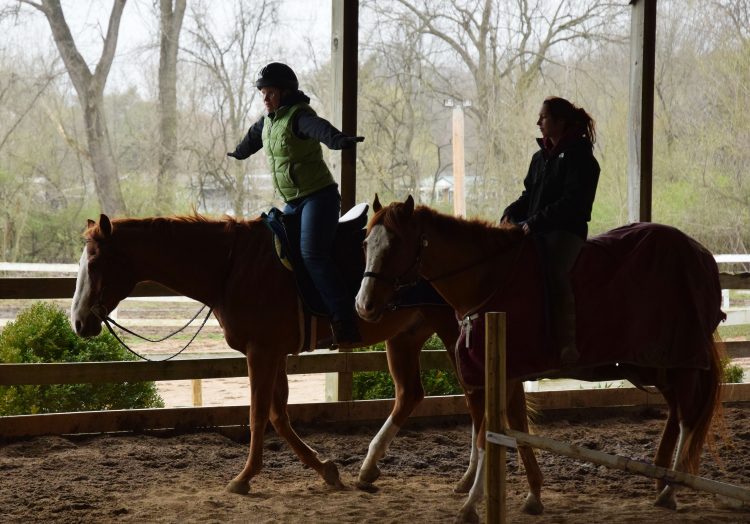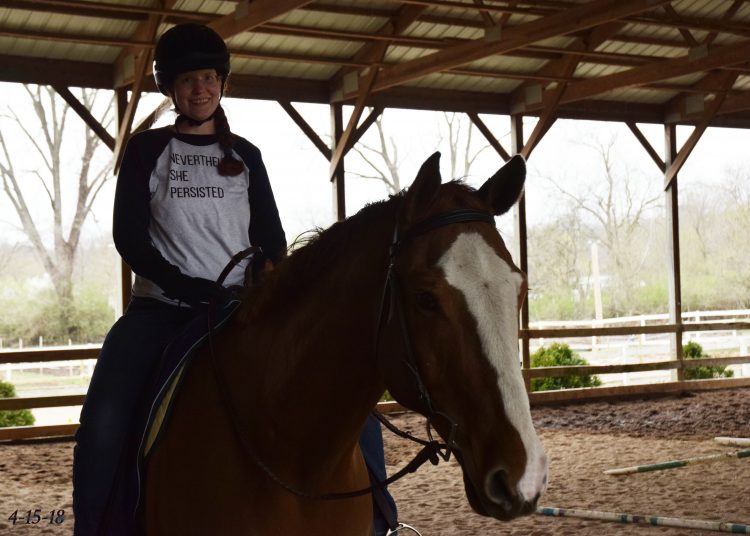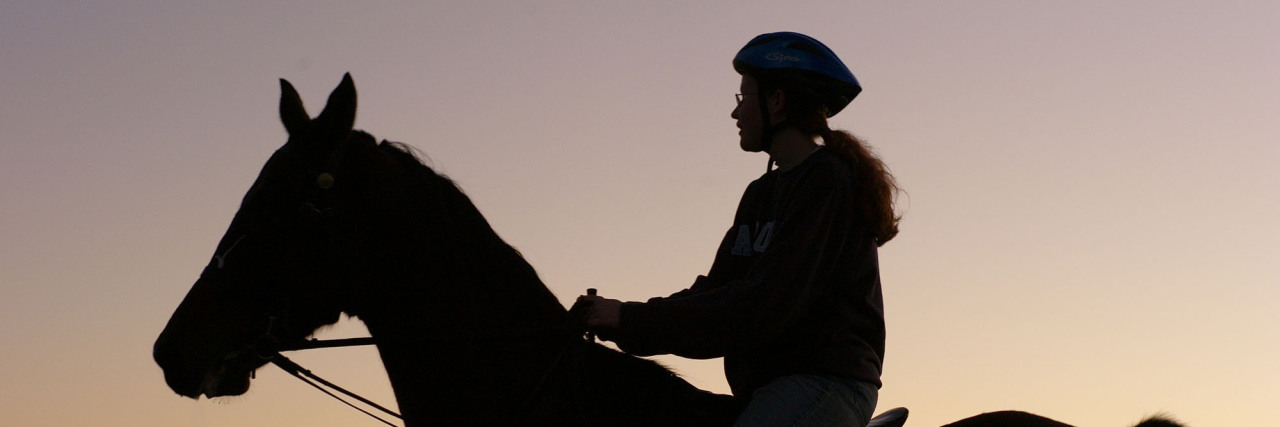“I’m sorry… I don’t know what to tell you. Our tests show nothing, but clearly something is wrong with your arm. You may have to face the fact that you will never ride horses again, Sally.”
“I don’t understand why you would throw it all away. You are a coward for not being able to take a little pain. You’ll never make it in the horse industry if you can’t handle pain.”

When I was 7, I rode my first horse. It was terrifying and exhilarating.
When I was 11 or 12, I bonded with my first “problem” horse. He was afraid of people, because he’d been abused. Over time, I earned his trust, and taught him people weren’t scary. A few months later, his owners were able to ride him for the first time.
When I was 16, during the summer, I spent 12 hours a day working at the barn. I cleaned stalls, groomed show horses, tacked up lesson horses, and rode. Being at the barn, working hard, coming home exhausted and covered in horse grime… that was my version of heaven.
That summer I declared to my trainer that I wanted to be a horse trainer, and go to horse college. He said, “OK, but you’re going to my college.” And I did.
The plan was to attend four years at a horse college, learn to ride Western, Dressage, and Hunter/Jumper, and to learn all I needed to be a horse trainer, run my own business, and do equine photography on the side, because everyone knows you don’t make money training horses.
When I started college, I was 18 and had been riding horses for 11 years.
The plan was to ride. My mantra has always been “I will ride on.” The plan was to ride. The plan wasn’t to become disabled.
A few months into my first year of college, I stopped a horse from bolting with me, but the maneuver to stop him triggered a severe chronic pain condition called complex regional pain syndrome (CRPS). We didn’t know that at the time, though. It took us 14 doctors and six years to get that answer, plus another two years to find out the condition was actually genetic. This meant it would have “woken up” eventually, even if that horse hadn’t bolted with me.
While at college, I tried to ride on through the pain. This pain isn’t like normal pain, though. I could feel it eating away at me from the inside out. It stripped my muscles, drained my strength, and collapsed my body.
When I was 19, I stopped riding completely. I remember loping around the arena at school, fighting back tears, trying to burn the memory of what it felt like to feel the horse’s strides swallow the ground, and thinking… this is it. I’ll never feel this again. I’ll never ride again. My life is gone.
If I close my eyes, I am on the back of my favorite horse at college — a fire-breathing Arabian that was afraid of the world, but trusting of me. I remember one day in particular, when we loped outside and got it right. That day, we made no mistakes as a team. It was a perfect ride.
I have held onto that memory like a promise. Something that felt that natural, that freeing, and that much like home couldn’t be gone.
I refused to say it out loud, because if I did I was afraid it wouldn’t come true. I never stopped loving horses, or riding. I hated the pain for taking it away. I hated the thought of therapy riding, because I didn’t want to ride if I couldn’t have everything back. If I couldn’t ride like I used to, it wasn’t enough.
In learning to cope and live with chronic pain, I have accepted two things to be true. One, “I will ride on” has stayed in my life as a source of strength, because no matter what has happened, I always continue to fight back and push through. Two, my best is good enough. The second one is so huge for life with chronic pain, because accepting the new way of life means seeing the little accomplishments as big ones. Today I walked the dog — awesome! Today I washed dishes — great job! And it’s not patronizing, because it really is something to be proud of when you’re able to wade through the waves of pain crashing into you and still get things done. Most people would be in bed screaming if they had to experience the levels of pain I deal with every damn day, and instead of being in bed, I’m out there. I’m washing dishes, exercising my dog, or reaching milestones I never dreamed would be possible with CRPS.
My best is good enough. I will ride on. So I did.

When I was 25, I rode my first horse since identifying as and accepting myself as disabled. I didn’t trot. I didn’t lope or gallop. I didn’t do anything fancy. I walked. For 10 minutes, I rode a Percheron therapy horse at a walk, with the biggest grin on my face. My fiancé said he’d never seen me smile like that before, and we’d been together for 4 years.
I rode at a therapy barn for a bit, but later switched to riding at a friend’s farm. During the summer, I try to ride weekly or every two weeks. During the winter, I go months without riding, but I know it’s waiting for me.
We taught my service dog to walk alongside the horse when I ride, but he taught himself to look up at me every now and then to check in, to brace beside the horse to help me dismount, and when he isn’t beside me, he watches me intently from the sidelines. So intently that nothing else can distract him.
I started with a walk. Then a slow jog or pace. We started with airplane arms, reaching towards the mane or tail, ankle circles, and cognitive games.
When not riding, I exercise weekly with my service dog, and try to do strengthening exercises twice a week. I make myself be active, even on the bad days. Whether I’m able to do five minutes or 45 minutes on the stationary bike, it’s enough. If it’s the best I can offer that day, it is good enough.
I’m 26 now. My daily pain level is an 8 out of 10. I’ve been working with a service dog for two years. But I can ride again.
For my birthday, I was able to visit a friend from college, who actually owns one of the last two horses I rode while in college. We drove two hours to see her. It was cold, windy, and raining, but none of that mattered. For the first time in years, I rode for an hour. I used my core and legs to lift myself out of the saddle — an exercise that’s difficult for most healthy riders. I moved my legs back to Sonny’s tail, pulled them up like a jockey, and held them still while posting the trot. I lifted my arms out to the sides, back to his tail, up towards his mane, and up above my head, a feat that was only just accomplished this past winter. Posting the trot was one of the first goals I set for myself when I began riding again, and that day on Sonny was the first time I’d been able to achieve it successfully. I got called out on smiling like a goof, but I couldn’t stop.
Six years ago, putting both arms above my head was impossible. Six years ago, I was told that riding was impossible. Four years ago, I told myself exercise was impossible. I told myself, and was told by others, that riding even close to how I used to would be impossible.
Sometimes things are impossible, it’s a fact of life. Don’t believe the motivational poster that tells you otherwise.
However, with chronic pain, “impossible” has some flexibility. At one time, riding was impossible for me. Range of motion was impossible.
Here’s what I’ve learned: Impossible can be temporary 2. Impossible is sometimes possible if you’re willing to try, but trying can be daunting.
This past Christmas, my older sister gave me a shirt that reads, “Nevertheless she persisted,” and told me she wanted a photo of me wearing it, to frame with photos of her and my other sister, each wearing their copy of the same shirt. All of us have persisted through our own struggles, so it’s fitting. I told her I’d get her that picture, and it would be a photo of me doing something we never thought I’d do again.
Riding Sonny, I wore that shirt and felt immense pride. They told me I’d never ride again. I told myself I’d never ride again. Not only did I ride again, but I can even imagine a future day when I will ride like I once could. It would probably not be training the crazy “problem” horses like before, but it would feel like I am strong again. I have no clue what my future with CRPS looks like, but now that I’ve got it back, I know riding will always find a way to compromise with the pain to keep riding possible.
I will always find a way to ride on. My best really is good enough.
Nevertheless, I persisted.

